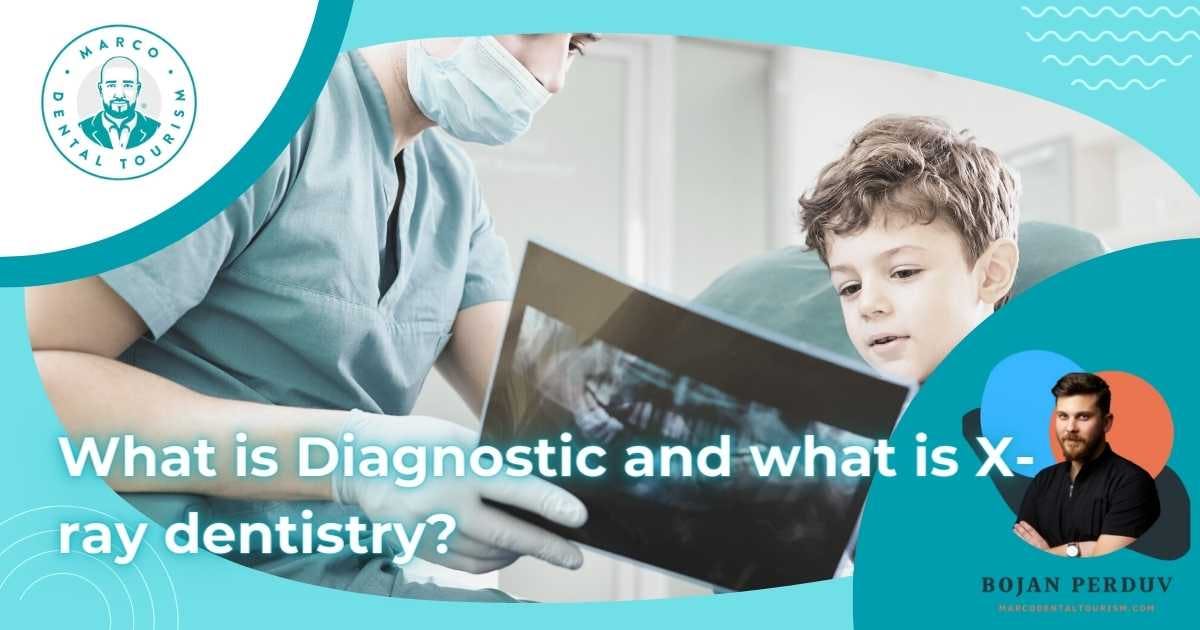Diagnostic and X-ray dentistry

We all know that going to the dentist is sometimes not a pleasant experience, on the contrary, it is often filled with anxiety and fear. But what if you walked into a dental office and were simply blown away? The dental industry, along with the development of modern technology, does everything to make dentist visits more efficient, comfortable, and even pleasant. To ensure that our teeth and gums remain healthy, we must be proactive in monitoring and maintaining good oral health. That's why today we deal with the latest developments in this field, explore the ways in which modern technology helps in identifying dental problems and answer all the questions and concerns that we understand to be very important. Here we go!
What are diagnostics in dentistry?
Diagnostics in dentistry is the process of identifying oral diseases, disorders and abnormalities. It involves the use of advanced imaging technologies, such as X-rays and CT scans, to provide accurate diagnoses. With the right diagnosis, treatment and dental care are guaranteed.
What does x-ray dentistry mean?

X-ray dentistry allows dentists to detect problems that are not visible by visual inspection. It helps identify cysts, abnormal growths and fractures that are hidden beneath the surface. X-ray dentistry is an important tool for early detection and prevention of dental diseases.
What types of dental imaging are there?

Dental imaging technologies have revolutionized the ability to recognize and treat various dental problems. Common types of recordings often include:
X-ray: An X-ray image shows the entire teeth, the root of the teeth, as well as the structure of the dental bones in detail and clearly. X-rays help to reveal the degree of caries involvement, identify infections or various dental damages.
CT scanner: The scanner is used to create a 3D image of the mouth and jaw. It can be used when planning any type of jaw surgery.
Intraoral imaging: With intraoral imaging, we obtain close-up images of teeth and gums. This type of recording is used in the diagnosis of decay, cracks or some types of tooth injuries.
Digital Impressions: Impressions are used to scan teeth and prepare them for crowns, bridges or other orthodontic applications.
Orthopan or panoramic x-ray: Creates a unique image of all teeth, upper and lower jaw and surrounding structures. It can detect cysts, tumors and impacted wisdom teeth.
Why is dental imaging important?

Dental imaging is important for detecting, monitoring and treating dental conditions. It helps dentists visualize the inside of the mouth, assess existing and potential problems, and plan treatments. Early diagnosis reduces the need for invasive procedures that can be long and painful.
Is dental x-ray safe?
Of course! Dental X-ray is a safe method that is essential for early detection and treatment of any dental problem. During imaging, a very low dose of radiation is used, so you can be sure that the benefits of X-ray radiation outweigh any potential risks.
How long does dental imaging take?
In almost every dental imaging center, the process usually takes about 15 to 20 minutes. Trained and experienced professional staff ensure that you get the best images of your teeth and jaws for proper diagnosis and treatment. Dental imaging is a fast and reliable way of establishing an early dental diagnosis.
What are the main diagnostic methods in dentistry?

In addition to X-ray, scanner and orthopan imaging, typical diagnostic procedures also include the following methods:
Laser caries detection: These devices can detect early cavities or the beginnings of caries in the enamel of the patient's teeth before they can be seen with the naked eye or in certain cases when they cannot be seen visually at all.
Jaw X-rays: These X-rays are used to diagnose cavities between the teeth and to check the health of the patient's jawbone.
Cancer screening: Oral cancer screening helps dentists detect all early signs of oral cancer in the patient's mouth in order to start the treatment process as soon as possible and efficiently.
What is the difference between an orthopan and a panoramic shot?
An orthopan is a specific X-ray that provides a top-down view of the entire mouth, while a panoramic is a single, more detailed X-ray that provides a side view of the jaw. Orthopan are usually used for diagnosis, while panoramic images are more often used to plan further treatment.
Is orthopan imaging completely painless?
Yes, imaging teeth is completely painless! The images are taken from inside the mouth and give you a clear overview of your teeth, jaw and dental anatomy. This makes it an excellent choice for people who want to keep their teeth and smile healthy.
What is cephalometry in dentistry?

Cephalometry is the study of the shape of the head and its relationship with the rest of the body. Cephalometry allows dentists to determine the size and shape of a patient's head, teeth and jaw. It is very useful in detecting jaw clenching, ie. bruxism as a frequent cause of headaches and other ailments.
What can be seen on a cephalometric scan?
Cephalometric dental scanning is the most accurate way to determine the health of teeth and jaw bones. The scan uses a series of X-rays to create a three-dimensional image of the teeth and jawbone. This image can help doctors diagnose problems with the jawbone, teeth and gums.
When is computed tomography used for diagnostic purposes?
CT is a frequently used diagnostic tool for the evaluation of dental pathology. It is the only imaging modality that can provide comprehensive information about the structure and function of the dental pulp and surrounding tissues. It is especially helpful in detecting caries and in assessing the extent and severity of certain periodontal disease.
Conclusion

Diagnostic and X-ray dentistry is a crucial, growing and exciting field of dentistry that provides high-quality dental care and service to an increasing number of people. With the help of diagnostic and X-ray dentistry, patients are given completely accurate diagnoses in order to receive the best possible dental care at all times. Diagnostic and X-ray dentistry is changing the way people look at dentistry and helping people enjoy their dental experiences every day.












Share your opinion!
What do you think about this topic?
Comments (0)